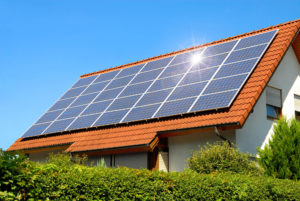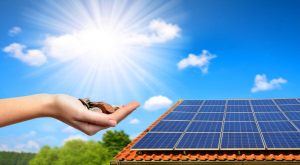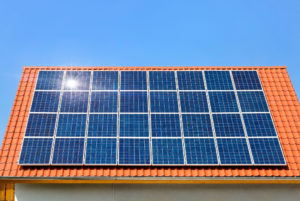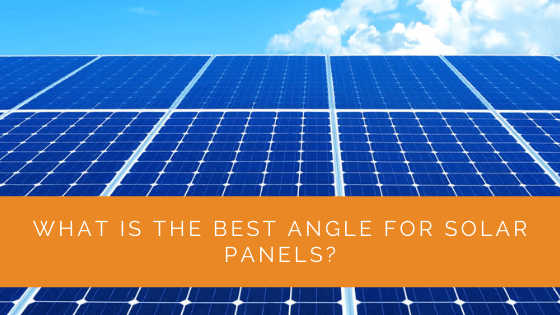The two most essential elements that act as catalysts in enhancing the energy you receive are the orientation and inclination of the solar panel. If you’re willing to dig deeper, examine how these factors affect the energy you receive.
Are you switching to environment-friendly options to use energy? Do you have a blue rooftop? Are you looking to optimize the power you receive from your solar panel? If the answer to all these questions was a resounding yes, you are in the correct place.
Furthermore, we will also look at which angle is the best suited for your solar panel. Read on to find out!
Contents
- 1 Key Takeaways
- 2 What Is a Solar Panel Angle?
- 3 What Is the Best Solar Panel Tilt for the Latitude You Live In?
- 4 How to Calculate the Best Solar Panel Angle for the Place You Live In
- 5 Which Solar Panel Tilt Is the Best for Each Season?
- 6 How Much Power Do You Lose if the Angle Is Not Perfect?
- 7 Which Direction Should the Panels Face?
- 8 Do Shallow and Steep Roof Angles Affect Solar Panels?
- 9 Case Study: Optimizing Solar Panel Angles for Maximum Efficiency
- 10 Expert Insights From Our Solar Panel Installers About the Best Angle for Solar Panels
- 11 Experience Solar Excellence with Us!
- 12 Conclusion
Key Takeaways
- The orientation and inclination (tilt) of solar panels significantly impact the energy they generate, and finding the optimal angle is crucial for maximizing power production.
- The best tilt angle for solar panels depends on your latitude. Panels at higher latitudes should have a steeper angle, while those at lower latitudes should have a shallower angle to capture the most sunlight.
- Adjusting solar panels seasonally can increase energy output, but it can be costly and tedious. To optimize energy production, it’s essential to mount panels strategically at an ideal angle based on your location and make sure they receive perpendicular sunlight.
What Is a Solar Panel Angle?
The changing position of the sun rays falling on your solar panel determines how much energy you will receive. Therefore, you need to ensure that your solar panels are positioned at an angle that receives energy at most times of the day.
The angle of a solar panel is also known as the tilt of the solar panel. From a quick search browse on the internet, you will notice that a solar panel angle is also referred to as the solar panel tilt. The two terms are used interchangeably.
So, without further ado, let’s understand the concept of solar panel angle. Solar panel angle refers to the vertical tilt of the photovoltaic cells in your solar panel system. When the solar panels are lying flat on the floor and are level, they have no tilt.
However, whenever the solar panels are positioned upright or perpendicular to the ground, they form a 90° angle. This angle – based on the latitude and the season – determines the amount of solar energy you are likely to receive.
So, when you adjust your solar panels according to these two factors, you will maximize solar power production.

What Is the Best Solar Panel Tilt for the Latitude You Live In?
Now that you know that latitude is one of the factors that affect the energy you receive from solar panels, you should know that the tilt of the solar panel should increase with the latitude.
In simpler terms, this means that – if your house is farther away from the equator, the tilt angle of your solar panel should be higher. And, if your house is closer to the equator, then the tilt angle should be lower.
So, if you live in a lower latitude, the sun will be higher in the sky. The photovoltaic solar panels require to be placed at a lower tilt to receive direct sunlight in such a place.
However, the sun is at a lower position in places that have higher latitudes. Therefore, the solar panels in these places should be installed at a higher angle to receive maximum sunlight.
So, the best angle for solar panels entirely depends upon the latitude of the place you reside in. The higher the latitude, the higher the angle of the solar panel tilt and vice versa.
How to Calculate the Best Solar Panel Angle for the Place You Live In
As complicated as this calculation sounds, it’s not! A simple rule will help you calculate the best tilt angle for the solar panels on your roof. All you have to do is the following:
- To determine the solar panel angle in summer, reduce 15 degrees from the latitude of your location. The outcome is the angle that your panels should be placed at.
- To adjust your solar panels during winter, add 15 degrees to your latitude. The resultant number is the angle that will help you achieve the highest energy output.
If you opt for a fixed installation, the methods given above will ensure that you receive an optimized energy level. It is pertinent to know that increasing the output of energy is possible by adjusting the angle of the solar panels according to the seasonal changes.
Which Solar Panel Tilt Is the Best for Each Season?
As we mentioned earlier, two elements affect the energy output produced by a solar panel – latitude and seasons. Since we already know the thumb rule behind latitude positioning, let’s look at the seasons and how they affect energy outputs.
You need to know that the angle of the sun changes based on latitudes but also seasons. In the winter months, the sun is lower in the sky. In contrast, the sun is positioned higher in the summer months.
So, what does this mean? It means that you will have to adjust the solar panels according to each season if you want to receive the maximum energy output.
A photovoltaic solar panel system at a 40° latitude will likely enjoy a replenishing energy boost of 4.1% even if you adjust it only twice a year. If you are looking for a better output, you can receive an additional 0.5% of output if you adjust your solar panels in the fall and spring.
It is pertinent to note that adjusting solar panels four times a year is a tedious task. Generally, solar panels are mounted on the roofs of houses. So, changing the angle every time takes time and money.
The easiest way solar panels can be regularly adjusted is to have a ground-mounted system for the solar panels. Additionally, you can also install axis-tracking solar panels, which enable you to switch the solar panels’ position easily.
Adjusting the solar panels surely increases energy output, but it increases the overall cost substantially.

How Much Power Do You Lose if the Angle Is Not Perfect?
Of course, it is not always possible to get the perfect angle all the time, especially because not all roofs are constructed according to the positioning of the solar panels. So, how much power do you lose when your solar panels are not positioned at the perfect angle?
The answer to this question entirely depends upon the orientation or the pitch of your roof. Any professional can calculate the percentage of energy loss while installing solar panels on your roof.
Furthermore, you can also do the same yourself. All you have to do is know the ideal angle at which your solar panels should be set. As mentioned previously, you can find out the perfect angle for your solar panels with the help of the latitude of the place you live in.
So, if the pitch of your roof is 15° and the ideal angle as per your latitude is 35°, you will lose 2% efficiency – as the difference between the ideal angle and your roof’s pitch is 20°.
If your roof is pitched at a higher angle, you will likely receive greater efficiency even if the angle is not perfect. However, it is best to mount the solar panels on a tilt frame that ideally suits your location if you have a flat roof.
This will help you maximize the total power output generated by the solar panels.
Which Direction Should the Panels Face?
It is no secret that sunlight determines the amount of energy you will receive throughout the day. So, whenever you decide to install a solar power system on the roof of your house, it is essential to pick the side of the roof that receives the maximum amount of solar radiation.
As discussed previously, solar panels are likely to give more energy output when the sun rays are perpendicular to the panel. So, for regions in the Northern hemisphere, the best orientation for panels is facing south.
In contrast, regions in the Southern hemisphere demand an orientation facing north. A slight change in the orientation of the panels is allowed as there might be objects that shade the panels.
Do Shallow and Steep Roof Angles Affect Solar Panels?
After reading those mentioned earlier, you must be wondering about roofs that allow a steep installation of panels against a shallow one.
Let us tell you that there’s little difference between the output received from panels installed at a steep angle compared to those at a shallow angle. Like we told you, the amount of energy received also depends upon the seasons of the place you live in.
So, the solar panels mounted on a shallow roof can capture plenty of sunlight during the summer season. On the other hand, solar panels mounted on a shallow roof will capture more sunlight and thus, produce more energy during the winter season.
Of course, you can purchase a solar panel tracker to identify the best position for solar panels at all times. However, the cost of the tracker and repositioning might be unappealing to a lot of people.
Therefore, it is alright for you to adjust the angles of solar panels slightly lower or higher according to the latitude of your place. The energy lost is compensated for in the different seasons throughout the year.

Case Study: Optimizing Solar Panel Angles for Maximum Efficiency
Background
At Solar Panels Network USA, our mission is to optimize solar energy production for our clients through precise installation techniques and strategic panel placement. Recently, we undertook a project to enhance the energy efficiency of residential solar installations by optimizing the tilt angles based on geographical latitude and seasonal variations.
Project Overview
The project aimed to demonstrate how adjusting the tilt angles of solar panels according to latitude and seasonal changes can significantly boost energy output. We selected a diverse range of residential homes across different latitudes to showcase the impact of proper tilt angle adjustments.
Implementation
- Initial Assessment:
- Conducted a thorough energy audit and geographical assessment for each home.
- Determined the optimal fixed tilt angle based on each location’s latitude.
- Tilt Angle Adjustments:
- For homes in higher latitudes, we installed panels with a steeper tilt to capture more sunlight during the lower sun positions.
- In lower latitudes, panels were set at a shallower angle to maximize exposure to the higher sun positions.
- Implemented seasonal adjustment recommendations, advising homeowners on how to tweak their panel angles for summer and winter.
- Fixed vs. Adjustable Mounts:
- Where feasible, we installed adjustable mounts to allow for easy seasonal adjustments.
- For homes where adjustable mounts were impractical, we optimized a fixed angle that balanced annual energy production.
Results
The strategic implementation of optimal tilt angles resulted in a marked increase in energy production across all participating homes. On average, households saw a 10-15% increase in solar energy output by aligning their panels to the recommended angles for their latitude and adjusting for seasonal changes.
Homes with adjustable mounts experienced the most significant benefits, with some seeing energy boosts of up to 20% during peak seasons. Fixed angle installations, while slightly less efficient, still provided a substantial improvement over standard flat or poorly angled installations.
Summary
Our project demonstrated the critical role of tilt angle optimization in maximizing solar panel efficiency. By tailoring the tilt angle to the specific latitude and advising on seasonal adjustments, we significantly enhanced the energy output for residential solar installations. This case study underscores the importance of precise installation and continuous optimization in achieving the best results from solar energy systems.
Expert Insights From Our Solar Panel Installers About the Best Angle for Solar Panels
Determining the optimal angle for solar panels is crucial for maximizing energy output. By aligning panels based on latitude and seasonal adjustments, we can ensure they capture the most sunlight throughout the year.
Senior Solar Engineer
Adjusting the tilt angle of your solar panels can significantly boost your energy production. In higher latitudes, a steeper angle is essential, while lower latitudes require a shallower tilt to optimize sun exposure.
Lead Installation Specialist
Seasonal adjustments, although beneficial, can be labor-intensive and costly. For many homeowners, finding a fixed optimal angle based on their location provides a practical balance between efficiency and cost.
Chief Installation Engineer
Experience Solar Excellence with Us!
Trust in Solar Panels Network USA, where our seasoned experts deliver top-quality solar solutions for homes and businesses nationwide. With a legacy of countless successful installations and a commitment to sustainable energy, we’re your reliable partner in the solar journey. Ready for a brighter, eco-friendly future? Call us now at (855) 427-0058 and harness the power of the sun!
Conclusion
So, determining the best angle for solar panels is not that complicated a task. It is entirely dependent upon the latitude of your place and the season you’re experiencing.
As we already know, the performance or the energy output of the solar panels is impacted by their inclination angle. To receive maximum power from the photovoltaic solar panels, you have to adjust the angle accordingly.
You can adjust solar panels four times a year to receive high energy at all times. However, this comes with the extra cost of re-orienting the solar panels time and again.
The best decision to avoid this is to mount your solar panels strategically in a manner where they are in perfect alignment as per the latitude.
You should ensure that your solar panels receive perpendicular sun rays to increase efficiency. Even if your solar panels can’t be perpendicular, slight changes to the angles are alright.
Solar panel systems are installed at various angles that cater to the unique roof shape, owing to the different shapes of roofs. If your solar panel is at the perfect and optimal angle, you will receive an increased energy production and a better output.
So, what are you waiting for? Mount those solar panels at the perfect angle to receive high energy all year long and save the environment!
About the Author
Solar Panels Network USA stands at the forefront of solar energy solutions, driven by a team of seasoned solar engineers and energy consultants. With over decades of experience in delivering high-quality solar installations and maintenance, we are committed to promoting sustainable energy through customer-centric, tailored solutions. Our articles reflect this commitment, crafted collaboratively by experts to provide accurate, up-to-date insights into solar technology, ensuring our readers are well-informed and empowered in their solar energy decisions.

